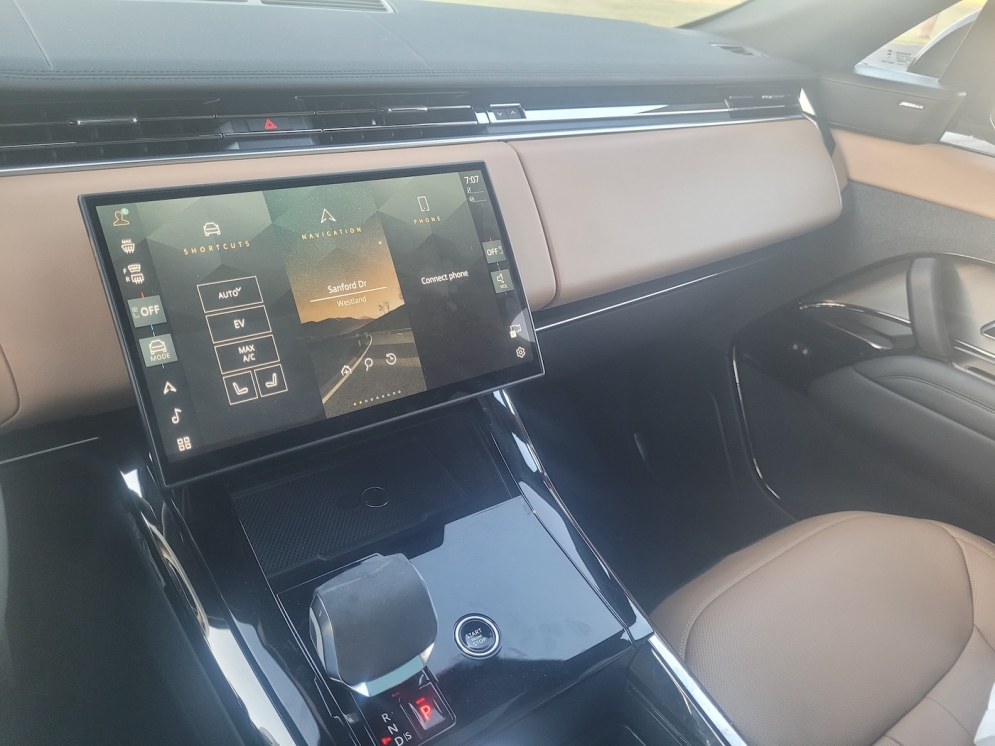LOOKS
The simplest way to describe the Range Rover Sport’s design is that it takes the bold, rugged and classy design of the full-size Range Rover and shrinks it down to a smaller, two-row package.
Keeping with Range Rover’s traditional design, it’s somewhat boxy but still delivers a sharp design that will draw a lot of attention.
Its massive, 23-inch wheels are imposing, attractive, and will help you ooze with confidence as you take the Range Rover Sport on journeys both on and off-road.
The Range Rover Sport features LED lighting, automatic high beam assist, fog lights, rain-sensing windshield wipers, plus power-folding and heated mirrors with memory settings. You also get a sliding panoramic roof, and its door handles are embedded — emerging from the vehicle as you approach, then returning to their hidden location once you lock up the vehicle.
Moving inside, you’ll see immediately why Range Rover vehicles are among the most highly sought-after luxury rides.
My test vehicle featured Caraway/Ebony Windsor leather seats that were extremely comfortable, well-made and high-end. Everything inside the Range Rover Sport exudes an upscale look and feel, as it should at this price point.
The vehicle featured: Illuminated vanity mirrors in the sunvisors, multi-zone climate control, power heated and ventilated front seating, reclining and heated rear seats, heated steering wheel, and even an in-vehicle air purification system.
Overall, it’s a clean design that incorporates the large touchscreen well.
Not only is there a ton of leg room and head room for all five passengers, there’s also ample small storage space for your keys, phone, wallet and other random items.
Cargo space is decent but not spectacular, at roughly 32 cubic feet behind the second row, and 53 cubic feet with the second row down. The back row folds down in a 40/20/40 split, and can be raised or lowered via controls in the rear of the vehicle. You can also raise and lower the vehicle to make loading cargo easier.
HOW’S THE RIDE?
The 2025 Range Rover Sport comes in a half-dozen powertrain options, two of which are offered on the plug-in hybrid version.
My test vehicle (a P460e model) featured a 3.0-liter, six-cylinder, plug-in hybrid engine, including a 31.8 kWh battery pack, that delivered 454 horsepower and 487 pound-feet of torque. This was paired with an 8-speed automatic transmission, and All-Wheel Drive (which is standard on all Range Rover Sport versions).
The Range Rover Sport PHEV features a Twin Speed Transfer Case, multiple driving and off-road modes, Hill Descent Control, and Dynamic Air Suspension. It also features Electronic Traction Control, Dynamic Stability Control and Roll Stability Control.
With the more powerful Range Rover Sport PHEV option (the P550e model), will get your numbers up to 543 horsepower and 590 pound-feet of torque, which is quite impressive. (Note: Across the six powertrain options, horsepower numbers on the Range Rover Sport will range from 355 to 626)
Both models will get you up to 53 miles of electric-only driving. Once the electric-only driving is tapped out, the vehicle will operate as a traditional hybrid until recharged.
For a vehicle that’s somewhat larger, the 0-to-60 times of the Range Rover Sport PHEV are quite impressive, coming in below 5 seconds (roughly 4.7 seconds to be more specific).
Overall drive quality is strong no matter what type of terrain you’re tackling, or what weather conditions you are facing. The Range Rover Sport PHEV is smooth and enjoyable to drive on regular roads, but has the Range Rover DNA that makes it quite capable if you find yourself in slippery or difficult conditions, or a bit off the beaten path.
It’s not only quick to accelerate, but also responsive to driver inputs and easier to maneuver than the larger, full-size Range Rover.
Specific off-road capabilities include the vehicle’s Wade Sensing system, which can assist with water crossings. As you prepare to cross flooded roads or bodies of water, sensors in the side mirrors measure the water depth around the vehicle in real-time, displaying it on your center touchscreen. The vehicle is equipped to handle a maximum wading depth of 33.5 inches, and when Wade Mode is selected, the system raises the suspension to its maximum height, locks the driveline, and closes the cabin vents.
Preset modes available to help as you navigate various terrains include:
— Grass, Gravel, and Snow
— Mud and Ruts
— Sand
— Rock Crawl
When properly equipped, the Range Rover Sport PHEV can tow over 6,600 pounds.
TECHNOLOGY, SAFETY
All the tech features in the 2025 Range Rover Sport PHEV are accessible through the large, 13.1-inch center touch screen, which features an advanced, high-tech setup. It includes a plethora of controls to master on the customizable screen, and there is not one physical dial or button to be found.
Some people will love this and quickly adapt, and others will hate it. But it's the way of the world in today’s modern vehicles, where traditional controls are becoming more and more rare every year. I was able to get used to the touch controls, but still found some elements to be overly complicated. The visual presentation, however, was truly classy, matching the rest of the vehicle.
Thankfully, the voice commands work very well in the Range Rover Sport, so people who do not like the touchscreen commands have another alternative to help them achieve their goals — whether that be controlling audio output, setting up navigation destinations or making phone calls via Bluetooth connection.
Satellite radio is offered (with a trial subscription), the system is compatible with Apple CarPay and Android Auto, and a wireless phone charger is included. There is also Amazon Alexa integration, and a handful of USB ports, plus a loud and booming Meridian sound system. An app is offered that will allow you to start the vehicle and lock/unlock it remotely.
The Range Rover Sport PHEV covers all bases when it comes to safety tech as well.
In addition to the usual array of airbags, you get:
— Tire Pressure Monitoring System
— Rear ISOFIX System for Child Seats
— Forward Collision Warning (including automatic braking when necessary)
— Anti-Lock Brakes and Emergency Brake Assist
— Adaptive Cruise with Steer Assist
— Blind Spot Assist (including rear cross-traffic warning)
— 3D Surround Camera System (helpful during tight parking situations)
— Rear Traffic Monitor
— Lane Keep Assist/Lane Departure Warning (steers vehicle back into its lane)
— Traffic Sign Recognition with Adaptive Speed Limiter
— Optional Head-Up Display (keeps driver focused on the road ahead)
All together, these systems will make you and your family feel quite safe on the roadways and ready for whatever might happen.
MPG, RANGE, CHARGING
The 2025 Range Rover Sport PHEV features a 53 MPGe rating, and a rating of 21 MPG once those electric miles have been used. These numbers are mostly competitive among luxury plug-in hybrid vehicles. They do trail some rivals, but not enough that fuel economy would be a major factor when comparing models.
There are also 53 miles of pure electric range in the Range Rover Sport PHEV, which is at the top of its class, so that’s another selling point for folks looking to minimize gasoline use.
As an example, people with short commutes could use EV power only to get both to and from work, and not use any gas in the process. Fully charging the vehicle at home to get those EV miles back will take about 4 hours with a 240V home charger, and I recommend home charging to all buyers of EVs and PHEVs.
PRICE
The 2025 Range Rover Sport PHEV that I tested was priced at $106,865. Its base price (Dynamic SE trim) starts around $97K, and can go as high as $120K (for the Autobiography trim level). Opting for the non-hybrid version will get your starting price closer to $80K.
There’s no way around the fact that Range Rover’s lineup is on the higher end of the scale for luxury car buyers. But they’re counting on fans of the brand to be loyal based on past experience and its premium qualities.
By comparison, hybrid offerings from luxury automakers such as BMW , Volvo, Lexus and Mercedes-Benz start in the mid-$70K range. The only brand starting at the heights of Range Rover’s pricing is Porsche, whose Cayenne E-Hybrid starts just under $100K — but that model is more about sportiness than the off-road ability the Range Rover Sport offers, so they’re not really comparable.
Warranties are respectable on the Range Rover PHEV, including:
— Four year/50,000 mile limited warranty
— Four year/50,000 mile powertrain warranty
— Eight year/1000,000 mile hybrid component warranty
However, there is no complimentary scheduled maintenance included.
BOTTOM LINE
The 2025 Range Rover Sport is a strong option for Range Rover fans who don't want the larger, full-size option. And now you can extend the fuel range with 53 miles of electric juice on the plug-in hybrid.
There are a wide variety of options in electric and hybrid options in the luxury category, but this is one of the stronger choices — as it’s classy, performs on and off-road, offers ample power and a smooth ride, and has green credentials.
===
AutoTechReviews.com can be found on Twitter @AutoTechReview, or stay updated at the AutoTechReviews Facebook page. Follow AutoTechReviews on Instagram at @Autotechreviews or on TikTok at @AutoTechReviews.. Matt Myftiu can be found on Twitter @MattMyftiu.




